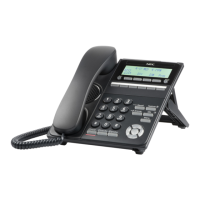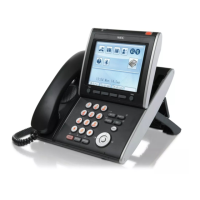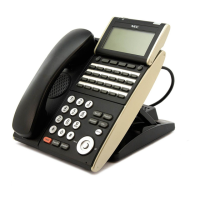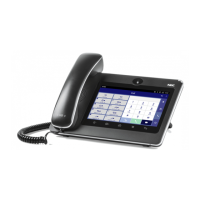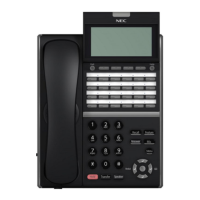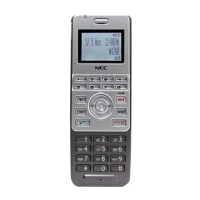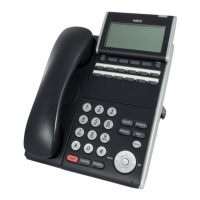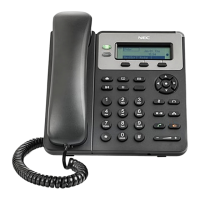
Do you have a question about the NEC Univerge SV9300 Series and is the answer not in the manual?
| VoIP Support | Yes |
|---|---|
| SIP Support | Yes |
| Unified Communications | Yes |
| Headset Port | Yes |
| Handset | Yes |
| Speakerphone | Yes |
| Display | Color LCD |
| Lines | Varies by phone model |
| Power over Ethernet (PoE) | Yes |
| Supported Codecs | G.711, G.722, G.729 |
| USB Port | Yes |
| HD Audio | Yes |
| Wall Mountable | Yes |
NEC Corporation reserves the right to change specifications, functions, or features without notice.
Read the document carefully before using the product and keep it accessible for future reference.
Describes the structure and content of the manual.
Explains the meaning of marks used in the manual for user guidance.
Defines key terms used within the manual for user understanding.
Details the terminal models, their features, and external appearance.
Lists the technical specifications of the UNIVERGE IP Phone DT820 series.
Explains the function of each key and physical part of the terminal.
Describes how programmable keys with LCD display provide dynamic information.
Provides step-by-step instructions for installing the terminal.
Guides on how to connect a headset to the terminal for audio communication.
Explains the different screens displayed on the terminal and how to navigate them.
Details LCD information, soft keys, and their functions.
Instructions on how to adjust handset, speaker, and ringer volumes.
How to enable or disable the ringing of the connected headset.
Guide to setting different ringer tones for internal and external calls.
How to enable or disable RTP Alarm notification for packet loss.
Explains how to set the audible tone generated when pressing digit keys.
Instructions for setting background music to be played during call holds.
How to control the display of volume levels for various audio settings.
Configuration options for activating the screen saver when the terminal is idle.
Procedures to turn the LCD backlight on or off for power saving.
How to enable or disable the smooth fading of the LCD backlight.
Information on changing the terminal's display language.
Steps to change the terminal's password for security purposes.
How to configure the usability features of the terminal, like key modes.
Guide on how to clear personal data and reset terminal settings to defaults.
Instructions for downloading files like Music on Hold and Ringer Tones.
How to back up and restore terminal configuration data to/from a server.
Procedures for logging into and out of the terminal to activate features.
Explains how to originate external and internal calls using the terminal.
Steps to answer incoming external and internal calls using the Answer key.
How to place an active call on hold using the Call Hold key.
How to place a call on hold, excluding other users from retrieving it.
Guides on transferring calls to other terminals with or without announcement.
How to redial previously dialed numbers from the call history.
Using speed dialing keys to quickly call frequently used numbers.
Registering and using abbreviated codes for faster dialing.
How to make calls that announce the caller's voice instead of ringing.
How to add additional parties to an ongoing call to create a conference.
Setting the terminal to answer calls by simply lifting the handset.
How to use the terminal for listen-only audio during calls.
Operating the terminal for calls without lifting the handset.
Answering calls directed to other extensions within a pickup group.
Picking up calls directed to any other terminal in the system.
Managing multiple lines or terminal numbers on programmable keys.
How to restrict incoming calls to the terminal.
Saving dialed numbers for quick redialing.
Entering a queue for outgoing calls when lines are busy.
Setting an automatic call back when a busy or unanswered extension becomes idle.
Setting a timed queue for outgoing calls when the called party is busy or unanswered.
Holding an active call to make or answer another call.
Routing incoming calls to another terminal in a hunt group when the primary is busy.
Calling an idle terminal by dialing an additional digit after reaching a busy one.
Camping onto a busy terminal to be alerted when it becomes available.
Overriding a busy condition on a called terminal for priority access.
Routing calls to another terminal when the current one is busy.
Forwarding calls to another terminal if there is no answer.
Rerouting all incoming calls to an alternate destination regardless of status.
Setting a specific destination for call forwarding.
Displaying the calling party's information on the LCD for incoming calls.
Setting incoming calls to ring or go to voice announcement.
Answering voice calls without lifting the handset.
Making voice announcement calls between two terminals using a line key.
Initiating intercom calls within a group by pressing a feature key.
Making intercom calls using a dedicated feature key and abbreviated dialing.
Paging terminals within assigned zones or all zones via built-in speakers.
Features for secretaries to manage calls for a boss, including message waiting.
Programming automatic calls to terminals at specified times for reminders.
Allowing another terminal to enter an ongoing conversation privately.
Registering return schedules for display on the calling terminal's LCD.
Allowing a secretary to interrupt a boss's conversation discreetly.
Adjusting the system clock using station dialing features.
Activating day/night mode changes by dialing a special code.
Recording and viewing numbers of dialed or received calls.
Storing up to 60 records of outgoing calls for review and redialing.
Storing up to 60 records of incoming calls for review.
Inverting LCD contrast for better readability in different lighting conditions.
Searching for contacts by name and initiating calls.
Adding and managing personal contact information in the directory.
Lists the main menu items available on the terminal.
Configuration options for user settings like incoming calls, talk, and display.
Procedures for downloading files such as Music on Hold and Ringer Tones.
Steps for backing up and restoring terminal settings and data.
Explains character input methods for system and menu operations.
Provides character code tables for various input scenarios.
